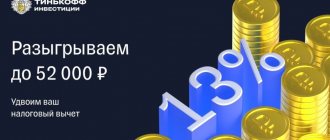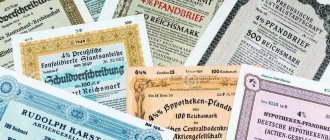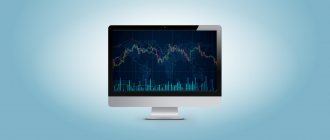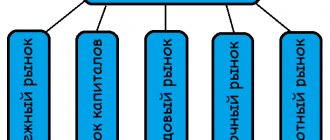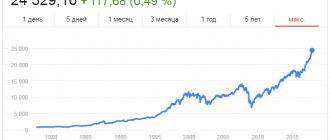What is an exchange
The stock exchange is the place where transactions for the purchase and sale of securities and mutual funds take place. There are other transactions taking place in the market, such as asset issuance and taxation. All transactions take place according to established rules that all participants adhere to. Thanks to the stock exchange, fair prices are established for financial instruments, since they directly depend on supply and demand from trading participants.
All transactions that take place on the stock market are recorded:
- Legal entities entering the stock exchange attract capital from private individuals for the development of the company.
- Individuals invest their own money and become investors. Every investor expects to make a profit from transactions, but this does not always happen and not for everyone.
Compliance with the trading rules is monitored by the exchange, which acts as a guarantor for all other participants.
Who issues securities
Shares and bonds are issued by private or public companies in order to expand production or build up infrastructure. They are called issuers of securities.
If an investor buys shares, he becomes a shareholder and can take part in the management of the company. If he takes bonds into his portfolio, he does not have such rights. The investor only puts his capital at the disposal of the company, and the issuer of the debt paper undertakes to return it under certain conditions.
When issuing securities, the issuer independently determines:
- quantity;
- par value – the value of the security;
- validity.
After issue, the papers are registered in a special register. After this, shares or bonds can be purchased on the market.
Bonds are most often issued to obtain new capital investment without diluting existing shareholders. A bond is essentially similar to a bank loan, only the lenders are individuals or other companies. It is much more difficult for a business to receive money from a bank than to issue debt receipts, so this option is ultimately more profitable for both companies and investors:
- the company does not pay interest to the bank for using borrowed money;
- the investor receives a higher profit for investing his own capital than if he had placed this amount in a bank deposit.
Bonds are a riskier type of investment compared to deposits, since investments, unlike money in bank accounts, are not insured by the state. To reduce risk, you can choose debt notes issued by states, municipalities or large corporations with state participation. The probability of bankruptcy of such structures is much lower than that of companies that are unknown to anyone on the market.
Who regulates the activities of stock exchanges
Compliance with the rules established on the exchange is controlled differently in different countries. The supervisory and regulatory function can be performed by one or more organizations at the same time, such as:
- stock exchange management;
- the main regulator of the country represented by the Central Bank;
- special commissions;
- non-profit authorized organizations;
- special government organizations.
Central banks issue licenses to stock exchanges and also collect and publish important information for all market participants. If the regulator reveals violations - illegal transactions, price manipulation, the license may be revoked, the exchange organizer may be fined, and the responsible persons may be removed from their positions.
According to Russian legislation, the activities of exchanges in the country are controlled by the Bank of Russia. In the United States, the stock market is regulated by a special Securities Commission, the SEC, which can go to court and initiate criminal cases against exchange participants. The Bank of Russia does not have such powers. The controller of the stock market in the UK is the Financial Conduct Authority FTA, in Japan - the Securities and Exchange Commission SECS.
The procedures and rules of operation of each exchange are established by law. In the Russian Federation, two federal laws “On the Securities Market” and “On Organized Trading” have been created for this purpose.
TOP 10 most profitable stocks
Regarding the question of what are the most profitable shares offered by the Russian stock market, in particular those traded on the MOEX exchange (MICEX), below is a table of such financial instruments.
Here it is necessary to clarify that the calculation of the profitability rating is carried out on the Moscow Exchange quarterly, relative to the corresponding quarterly period of the previous year, i.e. year to year. The last calculation of the profitability rating was made on December 21, 2022
For comparison, the Moscow Exchange index for the entire year showed rather average, although positive, dynamics, adding almost 27% (index value as of November 26, 2019 - 2940 index points).
| Tool | Price | Change prices, % | Capitalization, rub. | Rating update time | |
| 1 | AO system | 16,085 | 104,49 | 155 220 250 000 | 14:24:19 21.09 |
| 2 | GAZPROM JSC | 254,00 | 69,87 | 6 013 072 276 600 | 14:25:33 21.09 |
| 3 | Surgnfgs | 45,000 | 68,16 | 1 889 331 837 179 | 14:26:57 21.09 |
| 4 | GMKNorNik | 17 240 | 44,16 | 2 728 152 006 240 | 14:26:35 21.09 |
| 5 | Pole | 6 728,5 | 41,59 | 898 665 989 192 | 14:25:24 21.09 |
| 6 | Tatnft 3ap | 690,8 | 40,18 | 1 729 598 693 770 | 14:26:34 21.09 |
| 7 | Polymetal | 953,5 | 38,19 | 448 324 449 654 | 14:19:41 21.09 |
| 8 | Yandex clA | 2 635,8 | 37,28 | 771 228 899 049 | 14:18:30 21.09 |
| 9 | FIVE—GDR | 2 124,5 | 33,03 | 576 956 566 564 | 14:15:06 21.09 |
| 10 | LUKOIL | 6 060,0 | 31,08 | 4 545 000 000 000 | 14:26:55 21.09 |
| 11 | Sberbank—p | 215,40 | 29,37 | 5 288 332 780 000 | 14:26:52 21.09 |
| 12 | FGC UES JSC | 0,19754 | 28,67 | 251 797 387 918 | 14:23:49 21.09 |
| Moscow Exchange Index | 2 930,62 | 26,95 | — | — | |
| 13 | VTB JSC | 0,045880 | 25,02 | 594 629 636 557 | 14:24:29 21.09 |
| 14 | Sberbank | 235,00 | 24,67 | 5 288 332 780 000 | 14:26:57 21.09 |
| 15 | MTS-JSC | 304,50 | 23,03 | 608 507 189 588 | 14:26:12 21.09 |
| 16 | M Video | 480,1 | 20,18 | 86 306 725 783 | 14:24:17 21.09 |
Signs of the stock exchange
The stock market has several characteristics:
- fixed trading platform;
- a specialized mechanism for selecting assets traded on the market;
- implementation of time and work standards procedures;
- centralized processing of transactions;
- control of authorized bodies over the activities of all market participants;
- official quotes of all assets that are presented and selected on the market.
The classic structure of the stock exchange includes:
- Trading system , which is responsible for collecting offers for the purchase and sale of securities.
- A clearing house for keeping records of transactions of all market participants. It controls the debiting of the required amounts from the accounts of counterparties and the conduct of money transfers between the parties.
- A depository to control the transfer of securities from one market participant to another. Prepares the rights of new owners of the asset and settlement and clearing transactions.
- Independent registrars collect information about the owners and issuers of securities and transmit the information to potential investors. Maintain a general register of investors and turnover of the issuer's securities. In some cases, independent registrars are brought in to monitor large transactions or block the accounts of an individual or legal entity when violations are detected.
- Market makers maintain a price range between buying and selling within certain limits.
The operation of the exchange requires a multi-level infrastructure, which includes:
- functionality of the exchange itself;
- professional participants;
- technical participants;
- news agencies and business press.
Without the involvement of at least one of these levels, the activity of the stock market is impossible.
Regulation of financial markets
Stable functioning and successful development of the economy is ensured by competent regulation of financial markets. In global economic practice, there are two main models for regulating financial markets:
- The main control functions have been transferred to SROs (self-regulatory organizations);
- The main control functions are assigned to state institutions.
The Russian Federation operates a state model of regulation, in which regulatory activities are carried out by the Federal Service for Financial Markets (FSFM), the Federal Antimonopoly Service (FAS), the Ministry of Finance and the Central Bank.
What functions does the stock market perform?
The stock exchange ensures transparency of company information for potential investors. In order for shares or bonds to be offered at auction, issuers are required to provide reporting on key economic indicators. To be included in the first or second echelon of listing on the Moscow Exchange, a company must operate for at least 3 years, for which it is required to provide documented reports. In addition, the exchange checks compliance with other established rules.
The stock exchange performs several functions:
- supports fair pricing;
- acts as a guarantor of execution of transactions through the clearing center;
- includes and excludes assets from quotation lists.
In addition, the stock exchange develops ethical standards and a code of conduct for all trading participants.
Financial market activity
The activity of the financial market consists of the redistribution of financial assets on a fee basis. Also, the financial market is an accurate indicator that reflects the overall state of the economy (global or local). The efficiency of the financial market is determined by a set of economic indicators, which include the exchange rate, government debt, inflation rate, money supply, government budget surplus/deficit and balance of payments. The most important aspects of the financial market are intertemporal trading, capital flows, saving distribution costs and facilitating the process of continuous production within economic cycles.
Types of stock exchanges in the Russian Federation
Stock exchanges are classified according to different criteria:
- Product type: stock, commodity, currency or cryptocurrency.
- Form of organization: commercial, state or mixed.
- Type of participation: open and closed.
- Type of transactions: commodity, options, futures and mixed.
- International status: whether there is access to the international level or not.
In Russia, there are two platforms where investors conduct transactions - the Moscow Stock Exchange and the St. Petersburg Stock Exchange.
The Moscow Exchange group includes:
- stock market;
- currency – world currencies;
- forward – options and futures;
- monetary – repo transactions of the Central Bank and VEB;
- commodity – precious metals and grain;
- over-the-counter market – MOEX
For novice investors, the main goal is to enter the stock market of the Moscow Exchange to purchase shares, bonds or shares of investment funds. It is advisable to master more complex financial instruments gradually or under the guidance of an experienced manager.
The St. Petersburg Stock Exchange is not as developed as the Moscow Stock Exchange, but you can buy assets of foreign issuing companies on it. In addition, transactions with crude oil, petroleum products, timber, gas, agricultural products and energy resources are carried out in St. Petersburg. Private investors can conduct transactions on the St. Petersburg Exchange with certain foreign shares, bonds and depositary receipts without obtaining the status of a qualified investor.
Brief history of formation
The Russian stock market has a short history since the adoption of a course to liberalize the country's economy in 1991.
Can be divided into three periods:
- The emergence of the market from 1992 to 1998. At this time, it began to grow rapidly, which was accompanied by the widespread development of exchanges of various functional areas. In the mid-90s. The Russian stock market consisted of about 1000 exchange platforms. Some traded consumer goods, oil, timber, coal, carrying out transactions mainly through barter schemes. Others traded exclusively in foreign currency, while others worked in the GKO market and were engaged in voucher privatization.
- 1999 to 2008 After the crisis and default of 1998, the number of exchange platforms decreased significantly. There are only a few large regional stock exchanges left and two of general federal significance - RTS and MICEX. Shares of leading Russian companies were traded on them, IPOs were carried out, and OFZ trading began, including for the population. At this time, the Russian stock market was experiencing a real boom - money not only from Russian investors, but also from foreign ones flowed into it en masse. At the best time, their share reached almost 40%.
- 2008 to 2022 After the crisis, the Russian stock market lost a lot of its value - most non-resident investors left the Russian market irrevocably. They “stole” more than 200 billion dollars from him. True, there are still non-resident investors in OFZs, where their share reaches about 30%. The Russian stock market has become highly volatile, and many companies have left the market altogether, having been delisted on the stock exchange. More than 2/3 of the capitalization of the entire market is concentrated in shares of 40–50 issuing companies, which is not attractive even for a long-term investor.
The largest stock exchanges in the world
The world's largest stock markets are located in different countries, but the United States leads in terms of trading volume. The most famous exchanges are also located in China, the EU, Great Britain, Japan and India.
Top 10 stock exchanges in the world in 2022:
- New York Stock Exchange (NYSE) – USA
- National Association of Securities Dealers Automated Quotation (NASDAQ) – USA.
- Hong Kong Stock Exchange - Hong Kong.
- Shanghai Stock Exchange - China.
- Japanese exchange group Japan Exchange Group (JPX) – Japan.
- Euronext – European Union.
- Shenzhen Stock Exchange - China.
- London Stock Exchange London Stock Exchange (LSE) – UK.
- Bombay Stock Exchange (BSE) – India.
- National Stock Exchange - India.
Neither the Moscow nor the St. Petersburg exchanges are in the top. But for Russian investors, this stock market is the easiest to get into. Russians can access foreign exchanges through some brokers who offer such a service. At the same time, special restrictions have been established for civil servants when working with foreign exchanges and securities, which you need to know about so that there are no problems with the law.
How likely is a collapse?
Stock market crashes or collapses, as practice shows, never come when everyone expects them. So it is this time - the whole world is waiting for the collapse of the American, Chinese or European stock markets. But this doesn't happen. There is a simple reason for this - the governments of all leading countries are printing money, which stimulates the growth of both the stock market and consumer lending.
It is difficult to say how long this financial pyramid will grow. But, as one famous investor W. Buffett says, “trees don’t grow to the sky, and neither do stocks,” and neither do stock markets.
The Russian stock market, including over-the-counter securities, is a 100% reflection of all global trends. Therefore, as soon as a real collapse begins on world stock exchanges, Russian investors will immediately notice and feel it.
Stock exchange participants
Stock exchange participants are divided into professional and private.
There are 3 parties involved in securities transactions:
- Issuers . Companies that issue and sell their own securities.
- Investors . Individuals or companies that purchase the assets of issuers.
- Professional participants . Individuals or companies whose activities are directly related to the exchange - brokers, dealers, banks, management companies, qualified investors.
Professional participants are required to obtain a license and follow the rules. Private investors do not need a license, but they cannot enter the market without the mediation of a professional.
Investor reviews
Robert Nichtschulzer (CEO of an investment company).
Our company entered the Russian stock market in 1998. It’s difficult, you need to be able to understand the local specifics. But all these difficulties are always compensated by returns, which are much higher than on world-famous stock exchanges.
Alisher Kurmangaliev is a private investor.
The Russian stock market is very interesting for both novice investors and experienced speculators - I bought shares in Sberbank or Gazprom - and there are no problems. Sit and wait for your capital to grow. There is no difficulty in choosing from thousands of stocks, as in America.
What tools do participants use?
The main exchange instruments with which private and qualified investors conduct transactions:
- shares – ordinary and preferred;
- bonds – state, municipal, regional, corporate, exchange-traded, foreign, commercial;
- currency;
- precious metals;
- depositary receipts;
- units of mutual funds - open, closed, interval, exchange-traded;
- ETF fund units;
- futures;
- options.
The more issuers with similar characteristics come to the exchange, the wider the choice an investor has, which is why large-cap markets always have more participants.
Alternatives
Alternative options for investing money in Russian stock exchanges may now include such asset groups as:
- stocks and bonds of Southeast Asian countries. More growth prospects in dynamically developing economies;
- market of gold, silver and precious metals;
- antiques market, copyrights, technology, as well as art, wine collections;
- cryptocurrencies (first TOP 10 rating);
- assets denominated in dollars. The best way is in US dollars.
Types of transactions
There are two types of transactions in the stock market:
- for long-term storage - buy and keep;
- for speculation – purchase and sale of assets based on the fall and rise in the price of the asset.
In addition, transactions on the exchange are divided into several types according to the execution mechanism:
- cash spot transactions with payment within a minimum period;
- without cover;
- on credit, also called margin or “leveraged”;
- arbitration;
- urgent;
- fixed price or firm deals;
- futures;
- with floating cost;
- optional;
- prolongation.
By type of execution, transactions can be either immediate or deferred. If a private investor conducts a transaction on the Moscow Exchange, the “T+2” execution mode means that the actual operation will take place in 2 business days. This is convenient for some investors, since even if there are not enough funds in the account at the moment, he can have time to report them before the transaction is carried out.
List of indexes
The Russian stock market has only two main indices. These are two indicators:
- MICEX index - MOEX or MOEX 10.
- RTS Index - RTS.
In addition, the Russian stock market has a number of specialized indices that reflect business and market activity in the market in its various sectors:
- Oil and gas index - index code MOEXOG.
- Electricity Index - index code MOEXEU.
- Telecommunications Index - index code MOEXTL.
- Metals and Mining Index - index code MOEXMM.
- Finance index - index code MOEXFN.
- Consumer sector index - index code MOEXCN.
- Chemical and petrochemical index - index code MOEXCH.
- Transport index - index code MOEXTN.
- Moscow Exchange Index - RSPP Responsibility and openness.
- Moscow Exchange Innovation Index - index code MOEXINN.
- MOEX Russia Total Return - index code MCFTR.
- Moscow Exchange Government Bond Index - index code RGBITR.
In addition to these main indices, the Moscow Exchange calculates several dozen more different technical indices, which can be found in more detail directly on the exchange’s website by following the link:
https://www.moex.com/ru/indices
How to trade on the stock exchange
To trade on the stock exchange, a private investor needs an intermediary - a broker or trustee who will conduct transactions with assets on behalf of the client. If an investor creates his own portfolio, he only gives orders to the broker what to buy or sell. If cooperation with a management company is chosen, decisions are made by it. In both the first and second cases, the owner of the securities is a private investor.
When concluding an agreement with a broker or management company, be sure to check whether he has a license from the Central Bank.
All transactions between stock market participants are recorded by a special registrar . This is a special company that maintains a register of personal accounts indicating the personal data of the owner of the asset. The register helps to conduct shareholder meetings and when calculating dividends. The registrar operates on the basis of a license from the Bank of Russia.
All purchased securities of the investor are stored in the depository. Each client has a special deposit account. The investor, thanks to the activities of the depository, always knows how many and what kind of securities are in his ownership. When conducting a sale, the depository acts as a guarantor that this particular client has the right and currently owns the asset.
You can check the legality of the registrar and depository on the Bank of Russia website using a special link.
What are the risks when trading on the stock market?
An investor, unlike a depositor, is not insured against loss of capital. Any security or asset may lose value. Therefore, the investor must be aware of the full responsibility for the decisions made and be prepared for any turns. By entering the stock market, each participant assumes the following risks:
- Market . The stock exchange is dependent on both the economy and politics. Any event in the world of finance, both domestically and internationally, is reflected in quotes.
- Broker bankruptcy . In reality, this situation cannot be called a dead end. The investor will not lose his securities, since they remain his property. But it will take time to resolve issues and transfer assets to another broker.
According to the law, the broker has no rights to investors' assets. But in order not to face the bankruptcy of a broker, carefully select an intermediary to represent your interests on the stock exchange. Give preference only to experienced and well-known companies.
You can become an investor only when there is no fear of losing capital. At the same time, there should be savings for everyday needs and unexpected expenses. Transactions on the stock market are not a casino or a lottery. Successful investing requires knowledge and understanding of the processes in which you will participate.
There is not a single investor who always receives only profit. Most stock market participants prefer to remain silent about losses or failed transactions. In addition, it makes no sense to count on instant millions in profits with a small initial capital.
Many novice stock market participants make losing trades. But if they persist in learning and are able to draw conclusions from their actions, then they gradually gain experience and achieve success. If you don’t have the time or desire to dive into investments, it’s better to entrust the capital to a management company, choose a strategy and just monitor the results.
Give your rating
about the author
Klavdiya Treskova - higher education with qualification “Economist”, with specializations “Economics and Management” and “Computer Technologies” at PSU. She worked in a bank in positions from operator to acting. Head of the Department for servicing private and corporate clients. Every year she successfully passed certifications, education and training in banking services. Total work experience in the bank is more than 15 years. [email protected]
Is this article useful? Not really
Help us find out how much this article helped you. If something is missing or the information is not accurate, please report it below in the comments or write to us by email
Benefits of Technical Analysis
The main advantages of technical analysis include:
- the ability to use a small number of tools that can be obtained absolutely free;
- availability of additional indicators necessary for the formation of a trading system;
- high probability of accurately identifying the market segment, as well as entry and exit points.
At the same time, one can highlight the disadvantage of this type of analysis: since many people use it, people end up making similar decisions, which significantly changes market trends.
Comments: 0
Your comment (question) If you have questions about this article, you can tell us. Our team consists of only experienced experts and specialists with specialized education. We will try to help you in this topic:
Author of the article: Klavdiya Treskova
Consultant, author Popovich Anna
Financial author Olga Pikhotskaya
